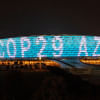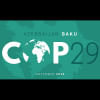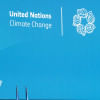A guide to COP29 climate jargon

With UN climate talks tackling complex topics from energy policy to global financial aid, the annual summit has developed its own ever-growing lexicon.
Here's a guide to some of the terms in play at this year's COP29 discussions.
UNFCCC: This acronym stands for the United Nations Framework Convention on Climate Change, which is the name of both the 1992 treaty committing nearly 200 countries to fighting global warming and the secretariat set up to implement that treaty.
COP: This acronym stands for Conference of Parties, and describes the annual summit of countries that have signed the UNFCCC treaty. This year's COP29 meeting in Baku marks the 29th such gathering since the UNFCCC took effect in 1994.
NCQG: This relatively new acronym will be focal at COP29. It stands for the New Collective Quantified Goal on Climate Finance, an annual target for funding developing country climate efforts.
NDC: Most often, these NDCs or Nationally Determined Contributions are referred to simply as "country pledges" and describe national action plans for reducing its emissions and adapting to climate impacts. The next round of NDCs are due in February, though some countries plan to submit new plans in Baku.
GLOBAL WARMING: The term describes the gradual increase in the global average temperature.
CLIMATE CHANGE: While this term is often used interchangeably with "global warming," it means something different. Climate change describes global warming as well as its consequences, such as extreme weather events.
GREENHOUSE GASES: These gases, sometimes referred to simply as GHGs, are able to trap solar heat in the atmosphere and cause global warming. The most powerful GHGs are methane (CH4) and carbon dioxide (CO2), which are also referred to as "carbon emissions" because both molecules contain carbon. The world's excess carbon emissions come mostly from the burning of fossil fuels and other industrial activities.
PARIS AGREEMENT: Under this 2015 treaty from the COP21 talks in Paris, countries agreed to try to limit global warming to "well below" 2 degrees Celsius (3.6F) above the pre-industrial average, with a goal of holding it to 1.5C (2.7F). The Paris pact also calls for national emissions-cutting pledges to be updated every five years.
NET ZERO: This term does not mean releasing zero emissions, but rather releasing no more than the amount being recaptured by CO2 abatement technologies, tree planting, or other means. Reaching "net zero" would mean atmospheric GHG concentrations stop increasing.
LOSS AND DAMAGE: Governments last year pledged $800 million toward a new 'loss and damage' fund to help poorer nations being hit by climate-fueled disasters. The fund, which now has a director and a host nation, will now be deciding how the funds should be dispersed and calling for more contributions at COP29.
CARBON OFFSET: Also known as a "carbon credit," these instruments allow a country or company to compensate for some of their carbon emissions by investing in projects to bring emissions down elsewhere.
ARTICLE 6: This term refers to a provision in the Paris Agreement on carbon offsets, and is used as shorthand for UNFCCC efforts to regulate international trading in carbon credits. Governments are hoping to resolve rules for trading carbon offsets at COP29 to allow for these markets to become operational.

 For all latest news, follow The Daily Star's Google News channel.
For all latest news, follow The Daily Star's Google News channel. 







Comments